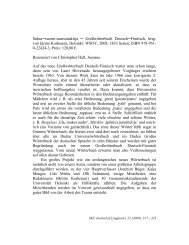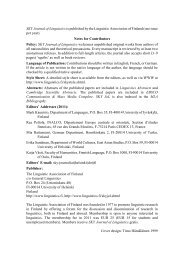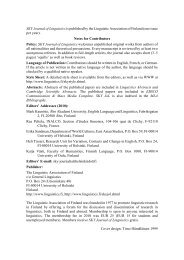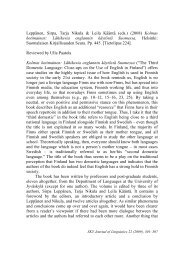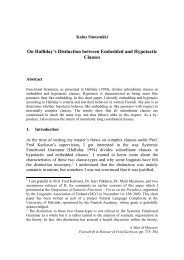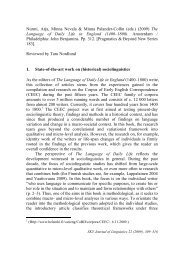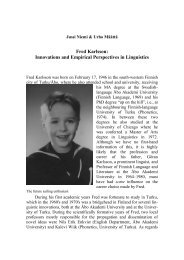'How Far from Origo?' or What the Distance Means for Nivkh ...
'How Far from Origo?' or What the Distance Means for Nivkh ...
'How Far from Origo?' or What the Distance Means for Nivkh ...
You also want an ePaper? Increase the reach of your titles
YUMPU automatically turns print PDFs into web optimized ePapers that Google loves.
192<br />
EKATERINA GRUZDEVA<br />
qualitative (e.g. ES təmd id ‘like this (by quality)’, həmd id ‘like that (by<br />
quality)’), (iv) quantitative (e.g. ES tuŋs ‘like this (by quantity)’, huŋs ‘like<br />
that (by quantity)’), and (v) dimensional (e.g. ES tun ‘like this (by size)’)<br />
pronouns. While <strong>the</strong> semantics of object and locational demonstratives is<br />
basically limited to deictic features, <strong>the</strong> last three subclasses provide also<br />
some additional inf<strong>or</strong>mation about <strong>the</strong> referent, such as its quality, quantity,<br />
<strong>or</strong> size. The semantic contrast is indicated through different demonstrative<br />
roots, which have common initials encoding <strong>the</strong> distance of <strong>the</strong> referent to<br />
<strong>the</strong> speaker. The most differentiated distance contrast is found in <strong>the</strong> group<br />
of object demonstrative pronouns, which is in <strong>the</strong> focus of <strong>the</strong> present<br />
study.<br />
3. Object demonstrative pronouns<br />
Demonstratives are known to be used in a range of domains. Four maj<strong>or</strong><br />
usage types of demonstratives are established cross-linguistically:<br />
exoph<strong>or</strong>ic (situational), discourse, anaph<strong>or</strong>ic, and recognitional (cf.<br />
Himmelmann 1996: 218–243). Acc<strong>or</strong>ding to my data, <strong>Nivkh</strong> object<br />
demonstrative pronouns can serve only exoph<strong>or</strong>ic and anaph<strong>or</strong>ic functions.<br />
Those are consecutively discussed in <strong>the</strong> following sections.<br />
3.1 Exoph<strong>or</strong>ic use<br />
When used exoph<strong>or</strong>ically, demonstratives serve a language-internal<br />
function: <strong>the</strong>y focus <strong>the</strong> hearer’s attention on entities in <strong>the</strong> speech situation<br />
and are characterized by <strong>the</strong> following three features that distinguish <strong>the</strong>m<br />
<strong>from</strong> all o<strong>the</strong>r uses: (i) <strong>the</strong>y involve <strong>the</strong> speaker as <strong>the</strong> deictic center; (ii)<br />
<strong>the</strong>y indicate a deictic contrast on a distance scale, and (iii) <strong>the</strong>y are often<br />
accompanied by a pointing gesture (cf. Diessel 1999: 94).<br />
All <strong>Nivkh</strong> object demonstrative pronouns can be used in <strong>the</strong> exoph<strong>or</strong>ic<br />
function. The semantic basis of <strong>the</strong> system is a five-term (ES) <strong>or</strong> four-term<br />
(A) contrast along <strong>the</strong> primary dimension of distance to <strong>the</strong> speaker. The<br />
speaker has a clear conception of surrounding space, which is divided into<br />
easily identifiable areas: once <strong>the</strong> referent (e.g. ‘dog’) is located in an area,<br />
it can be referred to by <strong>the</strong> c<strong>or</strong>responding pronoun (<strong>the</strong> f<strong>or</strong>ms in each set<br />
come <strong>from</strong> different subdialects):



